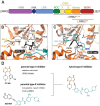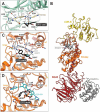This is a preprint.
Type-II kinase inhibitors that target Parkinson's Disease-associated LRRK2
- PMID: 39554022
- PMCID: PMC11565912
- DOI: 10.1101/2024.09.17.613365
Type-II kinase inhibitors that target Parkinson's Disease-associated LRRK2
Update in
-
Type II kinase inhibitors that target Parkinson's disease-associated LRRK2.Sci Adv. 2025 Jun 6;11(23):eadt2050. doi: 10.1126/sciadv.adt2050. Epub 2025 Jun 4. Sci Adv. 2025. PMID: 40465731 Free PMC article.
Abstract
Aberrant increases in kinase activity of leucine-rich repeat kinase 2 (LRRK2) are associated with Parkinson's disease (PD). Numerous LRRK2-selective type-I kinase inhibitors have been developed and some have entered clinical trials. In this study, we present the first LRRK2-selective type-II kinase inhibitors. Targeting the inactive conformation of LRRK2 is functionally distinct from targeting the active-like conformation using type-I inhibitors. We designed these inhibitors using a combinatorial chemistry approach fusing selective LRRK2 type-I and promiscuous type-II inhibitors by iterative cycles of synthesis supported by structural biology and activity testing. Our current lead structures are selective and potent LRRK2 inhibitors. Through cellular assays, cryo-electron microscopy structural analysis, and in vitro motility assays, we show that our inhibitors stabilize the open, inactive kinase conformation. These new conformation-specific compounds will be invaluable as tools to study LRRK2's function and regulation, and expand the potential therapeutic options for PD.
Conflict of interest statement
Competing interest statement Authors declare that they have no competing interests.
Figures






Similar articles
-
Type II kinase inhibitors that target Parkinson's disease-associated LRRK2.Sci Adv. 2025 Jun 6;11(23):eadt2050. doi: 10.1126/sciadv.adt2050. Epub 2025 Jun 4. Sci Adv. 2025. PMID: 40465731 Free PMC article.
-
Structural basis for Parkinson's disease-linked LRRK2's binding to microtubules.Nat Struct Mol Biol. 2022 Dec;29(12):1196-1207. doi: 10.1038/s41594-022-00863-y. Epub 2022 Dec 12. Nat Struct Mol Biol. 2022. PMID: 36510024 Free PMC article.
-
Cryo-electron tomography reveals the microtubule-bound form of inactive LRRK2.bioRxiv [Preprint]. 2024 Jun 20:2024.06.18.599606. doi: 10.1101/2024.06.18.599606. bioRxiv. 2024. PMID: 38948781 Free PMC article. Preprint.
-
Exploring the focal role of LRRK2 kinase in Parkinson's disease.Environ Sci Pollut Res Int. 2022 May;29(22):32368-32382. doi: 10.1007/s11356-022-19082-5. Epub 2022 Feb 11. Environ Sci Pollut Res Int. 2022. PMID: 35147886 Review.
-
The Cell Biology of LRRK2 in Parkinson's Disease.Mol Cell Biol. 2021 Apr 22;41(5):e00660-20. doi: 10.1128/MCB.00660-20. Print 2021 Apr 22. Mol Cell Biol. 2021. PMID: 33526455 Free PMC article. Review.
References
-
- Willis A. W., Roberts E., Beck J. C., Fiske B., Ross W., Savica R., Van Den Eeden S. K., Tanner C. M., Marras C., on behalf of the Parkinson’s Foundation P4 Group, Alcalay R., Schwarzschild M., Racette B., Chen H., Church T., Wilson B., Doria J. M., Incidence of Parkinson disease in North America. npj Parkinsons Dis. 8, 170 (2022). - PMC - PubMed
-
- Paisán-Ruíz C., Jain S., Evans E. W., Gilks W. P., Simón J., Van Der Brug M., De Munain A. L., Aparicio S., Gil A. M., Khan N., Johnson J., Martinez J. R., Nicholl D., Carrera I. M., Peňa A. S., De Silva R., Lees A., Martí-Massó J. F., Pérez-Tur J., Wood N. W., Singleton A. B., Cloning of the Gene Containing Mutations that Cause PARK8-Linked Parkinson’s Disease. Neuron 44, 595–600 (2004). - PubMed
-
- Zimprich A., Biskup S., Leitner P., Lichtner P., Farrer M., Lincoln S., Kachergus J., Hulihan M., Uitti R. J., Calne D. B., Stoessl A. J., Pfeiffer R. F., Patenge N., Carbajal I. C., Vieregge P., Asmus F., Müller-Myhsok B., Dickson D. W., Meitinger T., Strom T. M., Wszolek Z. K., Gasser T., Mutations in LRRK2 Cause Autosomal-Dominant Parkinsonism with Pleomorphic Pathology. Neuron 44, 601–607 (2004). - PubMed
-
- Satake W., Nakabayashi Y., Mizuta I., Hirota Y., Ito C., Kubo M., Kawaguchi T., Tsunoda T., Watanabe M., Takeda A., Tomiyama H., Nakashima K., Hasegawa K., Obata F., Yoshikawa T., Kawakami H., Sakoda S., Yamamoto M., Hattori N., Murata M., Nakamura Y., Toda T., Genome-wide association study identifies common variants at four loci as genetic risk factors for Parkinson’s disease. Nat Genet 41, 1303–1307 (2009). - PubMed
-
- Simón-Sánchez J., Schulte C., Bras J. M., Sharma M., Gibbs J. R., Berg D., Paisan-Ruiz C., Lichtner P., Scholz S. W., Hernandez D. G., Krüger R., Federoff M., Klein C., Goate A., Perlmutter J., Bonin M., Nalls M. A., Illig T., Gieger C., Houlden H., Steffens M., Okun M. S., Racette B. A., Cookson M. R., Foote K. D., Fernandez H. H., Traynor B. J., Schreiber S., Arepalli S., Zonozi R., Gwinn K., Van Der Brug M., Lopez G., Chanock S. J., Schatzkin A., Park Y., Hollenbeck A., Gao J., Huang X., Wood N. W., Lorenz D., Deuschl G., Chen H., Riess O., Hardy J. A., Singleton A. B., Gasser T., Genome-wide association study reveals genetic risk underlying Parkinson’s disease. Nat Genet 41, 1308–1312 (2009). - PMC - PubMed
Publication types
Grants and funding
LinkOut - more resources
Full Text Sources
Research Materials
